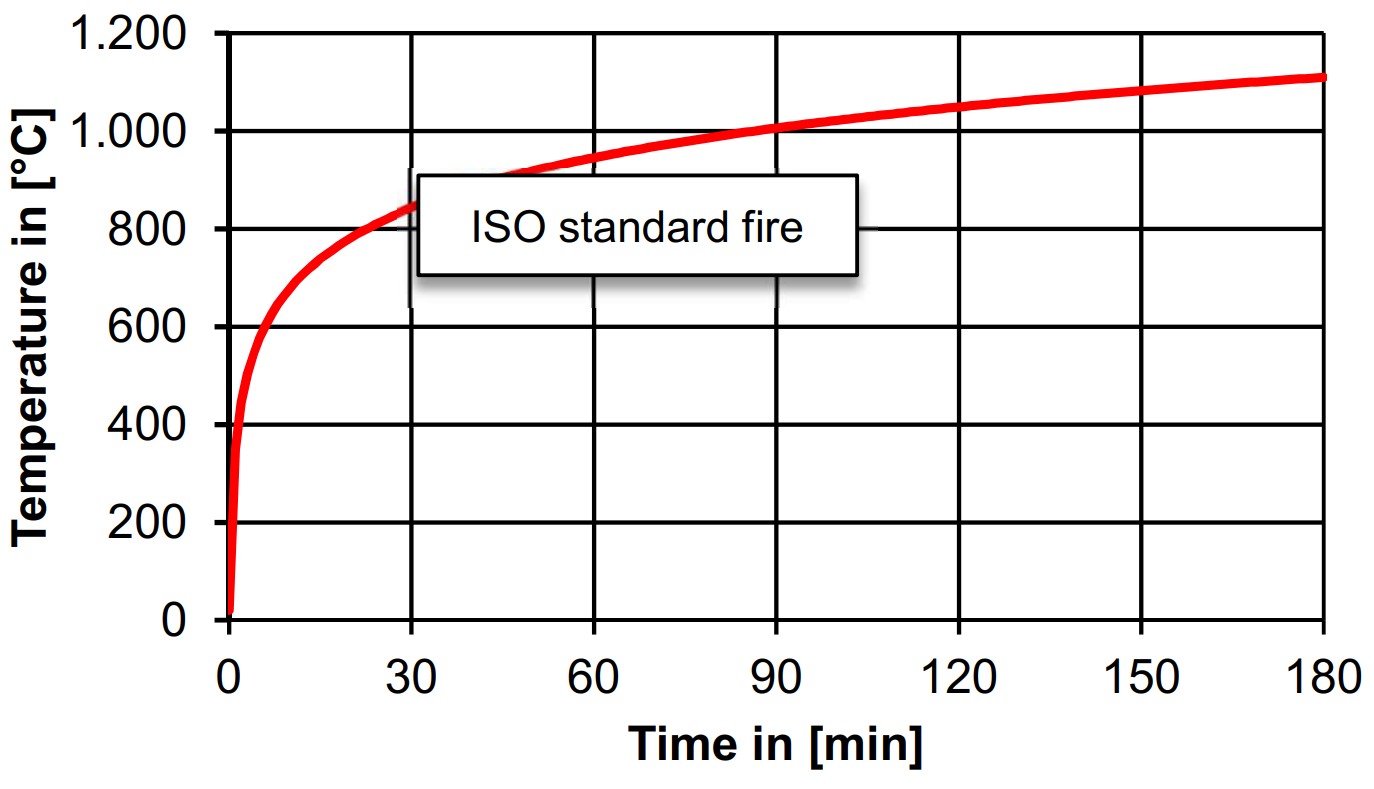The ISO standard fire curve
Scope of application of the ISO standard fire
The ISO standard fire curve is the most important curve for fire testing and in the fire design of structures. In colloquial terms, the curve is sometimes also abbreviated as "ISO fire" or "standard fire". Figure 1 shows the time-dependent fire temperatures according to the ISO fire. As you can see there, the temperatures never drop. This goes against a natural fire in which the fire load is burned at a certain time, so that the temperatures of course drop. Furthermore, the ventilation conditions (quantity of available oxygen) as well as the thermal properties of building (walls, roof and floor) influence the course of the fire. So-called natural fires are therefore much more irregular than the course of the ISO standard fire dictates. Therefore, the ISO standard fire is an artificial fire curve.

The ISO standard fire is described by the following equation, which can also be found in Eurocode EN1991-1-2:
Δθ(t)=20+345*log(8t+1)
In this equation the term Δθ is the gas temperature and the term t the time. By the way, if you enter a time in minutes in the table below, the fire temperature according to the ISO standard fire will be determined for you at this point in time.
The ISO standard fire corresponds to the standard curve of the international standard ISO 834, which is used in many countries. This artificial fire curve is the basis for uniform fire test conditions on members, allowing for a classification in fire resistance classes. In most cases, the assumption of the ISO standard fire will lead to conservative results.
On the other hand, this statement cannot be generalized, since under special circumstances fires can cause much higher temperatures, e.g. gasoline and tunnel fires. Given this condition, other temperature-time curves must of course be used, for example the RABT (guideline for the equipment and operation of road tunnels).
Historical background to the ISO fire curve
The ISO fire curve goes back to fire tests with wooden furniture and wooden cribs in the USA, which were carried out in the 1920s. It describes the phase of the full fire and neglects the development and decay phases of the fire. It was modified a little later in order to achieve a faster temperature rise in the first few minutes. Today the ISO fire curve is usually used for building structures. Alternative fire room curves can be used for other structures. For example the RABT tunnel fire curve for fires in tunnels. In the event of fires on oil platforms, ships or in industrial plants, the hydrocarbon fire curve is used.
However, the ISO standard fire is not undisputed (see e.g. Ariyanayagam and Mahendran). At the time of its development in the 1920s, wood was actually the most important fire load in buildings. In the meantime, there are considerable fire loads in the form of plastic and other synthetic materials in many buildings (e.g. residential buildings and offices). While the calorific value of wood is around 17 MJ/kg, this value is significantly higher for plastics at 25 to 35 MJ/kg. In the case of plastic fires, higher heat release rates can also occur because these fires are much faster and more intense.
Free tool
My free tool "Nominal temperature time curves according to EN 1991-1-2" evaluates the ISO standard fire curve, the external fire curve and the hydrocarbon fire curve for you. To use the tool, you must classify the macros in the Excel document as trustworthy.
How I can help you.
I can offer you a short-term fire design for your given task in the European Union or worldwide. The documentation contains the essential information on the heating of the cross-section, the fire resistance of the member or structure as well as its deformations. I can of course provide further services so do not hesitate to contact me.
What are your benefits?
My clients often save costs by using sophisticated fire design. In the case of new buildings, leaner and therefore more economical constructions can be carried out. In the case of existing structures extensive upgrading measures can often be avoided by an accurate fire design.
My initial consultation for your project
To clarify your specific task, it is best to call me. Or you can send me an e-mail with some key data. On this basis, we can discuss the framework conditions and I can create an attractive offer for you.